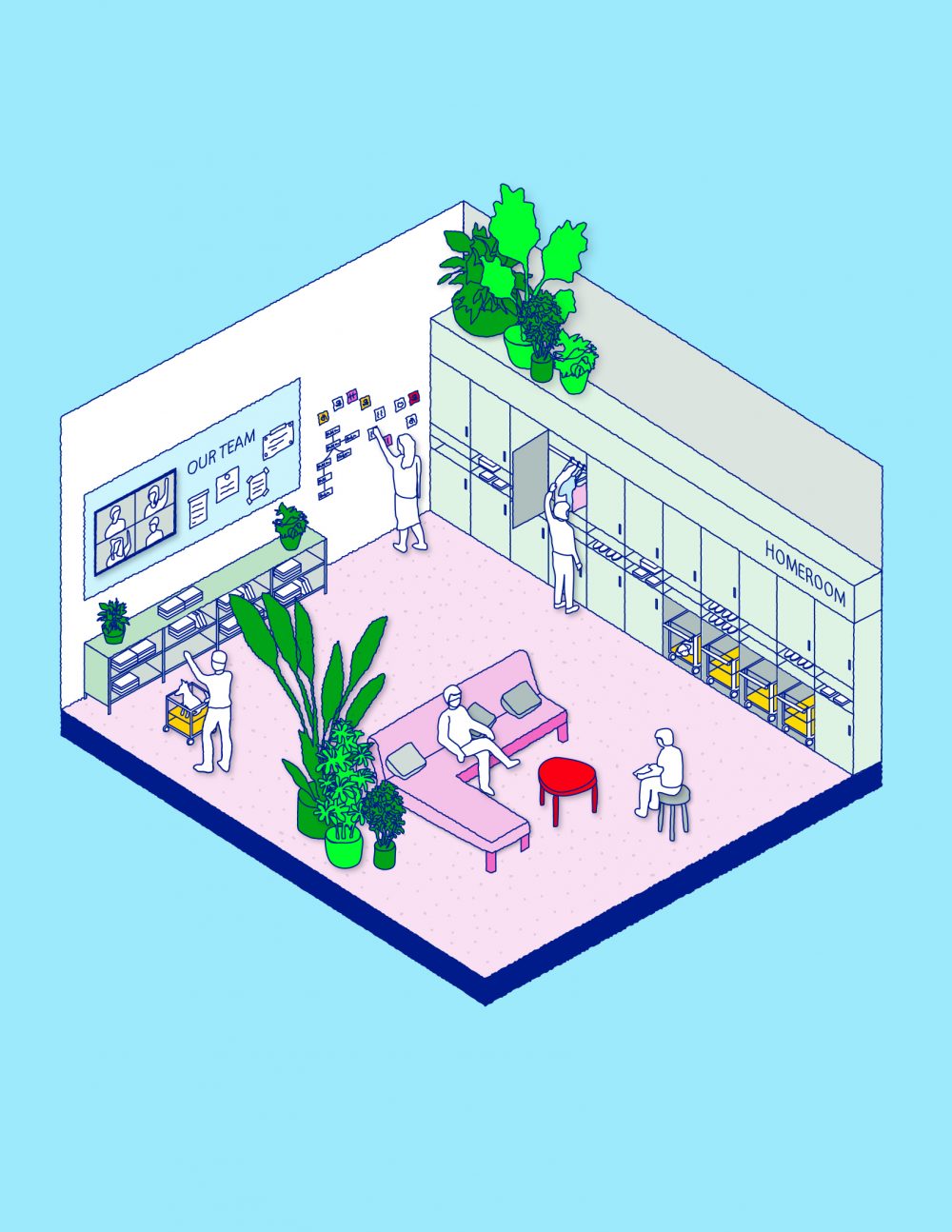Primo Orpilla of Studio O+A introduces the Home Room, a transitional space between the changing area and the work area, that we will see more of in 2021. Stay tuned for more 2021 trend predictions all month long!

One thing we’ve been doing since this extended work-from-home period began is trying to figure out what the post-pandemic work typologies will be. (Let’s hope we’ll get to post-pandemic in 2021). There’s a growing feeling among workplace designers that the lockdowns have showed us some new ways to function and that all things related to work—the spaces, the protocols, the structure of the work day—are up for reevaluation. There’s never been a better time to change what we don’t like about the old workplace and refine what we do like into something even better.
One of our new typologies is a team space called the Home Room. Initially we modeled it after the home room many of us experienced in high school, the basecamp space where students could go before or between classes. But as we got deeper into the necessities of post-pandemic protocols, the Home Room took on some important new features. It became a place both to celebrate team culture and a customizable “nest” for staff to personalize.
Until the virus is eradicated entering the office is going to be a more structured process than it was before. Even after COVID more health-conscious procedures are likely to continue. The days of coming to work in a rainstorm and arriving at your desk, dripping wet and with soaked shoes are probably over. We’ll miss them, but they’re history. The new office will have a Donning and Doffing Room where staff can change out of street shoes and outerwear into office slippers and whatever protective gear the times require. We took our cue from hospital workers whose donning and doffing procedures are formalized and uniform to give all staff confidence that everyone is observing the same level of care.
The Donning and Doffing Room will lead into the Home Room, a transitional space between the changing area and the work area. We see it as a bank of storage units for shoes, clothing and personal belongings. Each unit will be assigned to a particular employee and will include shelves for books, folders and other accessories. In addition to this personal cupboard, each employee will have a mobile storage cart, also parked in the Home Room to be wheeled out at the beginning of the day and returned to its designated space in the evening.
There’s never been a better time to change what we don’t like about the old workplace and refine what we do like into something even better.
This cart is probably the Home Room concept’s most radical innovation. We believe that in the 2021 workplace “your desk” is probably going away. Agility is the new priority in office design and the ability to work wherever you want—outside in a garden, inside by a window, in a quiet corner or at the center of a collaborative hub—will be a key element in achieving that sense of personal control over the workday. We believe many offices will adopt a floor plan with 100 percent unassigned workstations, an arrangement that will allow more flexible scheduling, easier adaptation to hybrid work-from-home/work-onsite strategies and simpler cleaning protocols. Workplace design has been heading in this direction since laptop computers first booted up. The pandemic now accelerates the shift.
But if the designated desk is soon to be history, people are still going to want a place to land. One of the reasons cubicles were popular is that they could be personalized into a nest. Think of the Home Room storage cart as a mobile nest. It’s the place to keep your desktop essentials—your stapler, tape and pens (in these germ-conscious times no longer shared); your laptop and the materials you were consulting yesterday; but also a photo of your sweetheart, the drawing your kid made of you in kindergarten, the souvenir calendar you brought home from Puerto Vallarta, your Giants bobble-head (or Red Sox, if you’re a troublemaker), your cactus or your fern—maybe your cactus and your fern. The Home Room mobile cart is a personal pirate ship to be sailed around the office from space to space flying whatever flag you please.
We believe the period of upheaval we are passing through has increased our appetite for community. Another unique feature of this typology will be its display wall for celebrating achievements and reinforcing team identity. Rebuilding company culture after months away from the office is sure to be an important element of getting back to normal. The Home Room, in addition to its storage and transitional functions, will be a kind of tribal space, a place for meeting informally and recognizing how individuals contribute to the progress of the group. If working in isolation has taught us anything it is that each person brings something unique to a work culture and that the culture supports each person through the force of its collective imagination. Workplace 2021 will be designed to make both parts of that exchange robust and meaningful.

